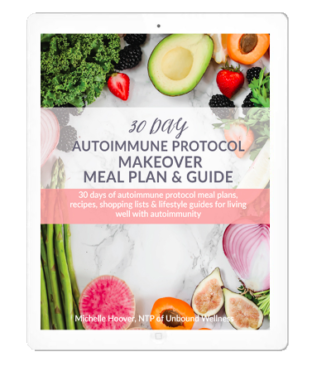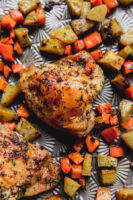How To Successfully Reintroduce Foods On A Gut Healing Protocol
This post contains affiliate links. Learn what that means here.
Gut healing protocols and elimination diets like the autoimmune protocol, GAPS, candida and even the Whole 30 are hard. They’re hard mentally, emotionally, socially, financially, and even physically. But being through them myself, I can say one-hundred-percent that they’re worth it… hard, but worth it. Even harder than eliminating foods can be the mystery of actually reintroducing them. Not just what to reintroduce and when, but how to get over the anxiety, how to keep the food in your diet and not develop another intolerance again, and more. This is a huge topic within the realm of gut healing, which is why I wanted to delve deeper into my own experience with this and how to reintroduce foods on a gut healing protocol.
My Experience Reintroducing Foods After Gut Healing Protocols
I remember my first appointment with my chiropractor who diagnosed me with leaky gut, so vividly. More than being completely over the fact that everything I ate made me sick, I was scared that I was just a total hypochondriac that she’d turn me away. That was anything but true. I found out that I had 40+ food intolerances from an IgG test. In retrospect, the test was definitely under counting and I don’t entirely recommend them. I had never heard on AIP or intense elimination diets at the time, so it was a necessary jolt to realize that I needed to do it, but the test never showed reactivity to corn, dairy, or other foods that I know I have a reaction to, so they’re heavily debated. Regardless, I was going to have to go on an elimination diet similar to AIP. Though having Hashimoto’s disease was a huge struggle, it quickly became apparent that healing my gut was going to be a huge battle.
The thought of getting rid of bread, pasta, potatoes, tomatoes, and more made me sick to me stomach and I was immediately expectant to reintroduce these foods. I’d count down the weeks, and the days until I could finally start to add these foods back in. That is, until I had my first bad reaction.
Having a bad reaction to a food that seemed fine before is your body telling you that it wasn’t fine… that it’s inflammatory and you shouldn’t be eating it.
There’s a lot of confusion about bad reactions around foods that you seemed fine with previously. Take gluten for example… maybe you ate bread daily and didn’t experience a reaction directly after eating bread.. you were just generally fatigued all of the time. Then you cut it out for 60 days, try to add it back in and have a horrible reaction… what happened? Previously, your immune system was so up-regulated to gluten that you didn’t even experience intense reactions because you were always having systemic inflammation. Now that you’ve calmed the inflammation on a daily basis, the reactions are far more noticeable.
My first experience with this reintroducing a food that I thought was fine but caused a reaction, set off this massive amount of anxiety and confusion around reintroducing foods. What was safe? What wasn’t?
After many mis-steps, I’ve successfully reintroduced….
- Almonds
- Egg yolks
- Occasional raw goat cheese
- White rice (and sometimes brown)
- Chocolate
- Decaf coffee
- Coconut (there was a time where I couldn’t eat it)
But I’ve massively failed at reintroducing…
- Egg whites (I get physically ill with a cold when I eat egg whites)
- Nightshades
- Beans & legumes
- Most tree nuts (I have an IgE allergy to most tree nuts)
- Corn (I basically turn into a zombie for days)
- Cow dairy
- Blackberries & pineapple (one of my weird allergies)
I’m still reintroducing things and my diet is always changing. I’m in a period of eating more low starch and will have to go through a process of reintroducing starch down the line all over again. It’s taken years to learn how to do it well, but that’s what I want to share with you today how I’ve been able to reintroduce things well.
How To Reintroduce Foods On a Gut Healing Protocol

1.Take the gut healing part of the process seriously
So many protocols just eliminate foods and don’t focus on healing. Though removing the food will lessen inflammation, it will never treat the root cause.
I’ve done it before, and I guarantee you’ll be in for a load of frustration if you just remove foods and don’t focus on really repairing the gut. You’re much more likely to be unsuccessful with reintroductions and just be back at square one having to keep removing over and over again. This is a very easy cycle to get stuck in and most folks that I know who have chronic issues and stay here for years.
Here’s what I recommend for taking gut healing seriously…
- Focus on healing foods and practices as outlined in my book, The 30 Day Gut Healing Diet Plan & Guide
- Work with a practitioner to get to the root cause of why your gut is damaged in the first place (parasites, dysbiosis, toxicity, etc.)
- Pursue functional stool analysis, blood testing, heavy metal testing and more to get to the root cause
- Really focus on healing your digestion! Relaxing before meals, chewing, taking proper enzymes etc.
I say often that in today’s super toxic world, gut healing is a constant effort. We can’t ever really act like our work is 100% done. It will never be done for me, and even when it gets better, we have to keep up with maintaining our gut health.
2. Reintroduce the least inflammatory foods first
When I went on my first gut healing protocol, I cut out all nightshades. At the time, I didn’t even know the connection between autoimmunity and nightshades, I only knew that tomatoes, potatoes, eggplant, peppers, and goji peppers it came up on my test.
Clueless of what these were or how to reintroduce, my first reintroduction was mashed potatoes. Like, a lot of mashed potatoes. Needless to say, I felt like crap the next day. Pounding migraine, fatigue, joint pain, stomach aches. It was bad.
Little did I know, this was one of the most inflammatory foods I could reintroduce. When reintroducing foods, start with the least inflammatory first, and work your way up from there.
If you’re looking for a good resource for reintroductions on AIP, I really like the e-book from Phoenix Helix, Reintroducing Foods On The Paleo Autoimmune Protocol. She has tons of instructions, recipes, and guides for what to reintroduce and when!
3. Take note of reactions and be careful of what foods are in the same family.
After my mashed potato mishap when I was 20, I still had no idea what I was doing. I was incredibly anxious about my first reintroduction and went for something that seemed benign… paprika. My mom is off the boat Hungarian and I figured that maybe, just maybe, I would be fine because paprika was in my genes. I put literally 1/2 tsp of paprika in a huge soup with at least 6 cups of broth. Even that much was enough to elicit a terrible reaction. I was aching, sweating, and fatigued for 72 hours, and even more confused.
What I didn’t know at the time was that paprika and potatoes are in the same family. So often, people are reacting to an entire family of foods rather than just one singular food. Foods can be categorized in tons of different families like nightshades, legumes, starches, fodmaps, crucifers, citrus, stone fruits, etc. The list goes on!
Let’s say you react to lemons and also have some issues with oranges in the past. These are both citrus, and it would be best to delay an orange reintroduction.
Look deeper into what food you react to and figure out what family/category it’s in and be cautious with that whole family during your reintroduction period.
4. Rotate your reintroductions (and your food in general)
One of the biggest mistakes that I see people make with food is they eat the same things every day, and all year round. In nature, we would never do this. Even before modern grocery stores (which have only been around for a century or so BTW) and we started shipping in things from all around the world, we weren’t able to eat mangoes in Idaho in the middle of December. They weren’t local, they weren’t in season, and it just wasn’t accessible. Now, we have everything at our finger tips and eat it whenever we want. Not only is this unnatural, it’s what can cause food intolerances by having these foods in excess.
The guideline is generally a four day rotation, and that’s what’s outlined in my e-book, The 30 Day Gut Healing Diet Plan & Guide. If you eat something on Monday, don’t eat it again until Friday. This is exactly what you should be doing with reintroduced foods. If you reintroduce potatoes, go easy on them. Don’t eat them daily, and be sure that you rotate all of your foods to avoid overdoing it and causing a reaction.
You don’t have to be 100%, but be mindful of not eating the same foods every day regardless of reintroductions.
5. Use your mindset in your favor
I know how anxiety inducing it is to reintroduce foods. I know how anxious chronic illness makes you in general… both as a symptom of the illness itself and of living with the illness in general.
However, our mindset is such a powerful tool in healing. We need to be in a relaxed state to even stimulate the hormones of digestion. Where as, if we’re anxious and keyed up about a reintroduction, we’re much more likely to have bad digestion and a poor reaction.
I know it’s hard, I know you’ve probably been burned in the past, but limiting anxiety round reintroducing foods is key to doing it successfully. I’ve had personal experiences where I’ve been able to tolerate different foods differently depending on how my current stress was around the food. Take a deep breath, think good thoughts, and trust that this reintroduction will work!
6. Use pulse testing to gauge potential reactions
I learned about Coca’s Pulse Testing for food sensitivities through the NTA, and I really love sharing it with my own clients and doing it on myself. Essentially, pulse testing taps into our bodies innate intelligence as to whether or not we can tolerate a food by testing how much our pulse speeds up when the food is in our mouth.
Here’s how you pulse test for food intolerance…
- Sit, relax, breath. Take a moment to calm down before you eat.
- Take your pulse for a full 60 seconds and write it down.
- Take a piece of food (one ingredient/food at a time) and chew and salivate it for about 20 seconds. Don’t swallow the food.
- With the food still in your mouth, record your pulse. If your pulse speeds up by 6 beats or more, you’re having a reaction to that food.
- Remove the food from your mouth if you reacted, and drink some water.
- Relax and repeat the process!
That’s all there is to it!
I’m not going to say that this is 100% accurate, because in my experience, no food intolerance test is. However, it is a great way to gauge your bodies reaction in the moment to a food.
All in all, All food is different… no apple is created equal. Our bodies and tolerances are always changing. I know how stressful it is to reintroduce foods, but I hope these tools help make the process a bit easier!
What are your tips for reintroducing foods? Leave your ideas in the comments to share with others! 🙂







I have been trying to reintroduce foods after a major elimination with many things listed above. I find that everything I have had to more recently introduce has still caused a reaction. It is frustrating because the reaction typically doesn’t occur until I am getting ready for bed. At this point I am worried foods are bothering me because its been so long since I’ve eaten them. I tried goat cheese last night, didn’t go well. I am leaving for disney in less than 2 weeks and wanted try gluten and legumes to see if there might be more foods I can enjoy there. I am also nervous for enzymes, worried those ingredients may cause a reaction (sugar often does for me). Any tips?? I am desperate. Thanks!
I have the same problem too, and with my reaction , my body tells me right away, i break out on my neck, been doing my research and it says it takes at least 6 months to heal a leaky gut, i say take at least 100 billion probiotics and some powerful enzymes
Thank you so much for your response! Unfortunately my body typically waits until night time so its hard to tell what set me off :/ Probiotics have helped a bit, what enzymes do you take?
Pingback: Fatigue, Food Reintroduction Symptoms & Carb Tolerance » Grass Fed Salsa
Pingback: The Complete Guide to the AIP Diet - Unbound Wellness
Once I’ve reintroduced one food and it’s ok, can I keep it in my diet while I reintroduce others or do I have to wait until I’ve reintroduced everything before I can eat that food again? As in, if I reintroduce eggs and don’t have a reaction, can I just go back to eating them or do I need to go off of them while I reintroduce dairy, and the nightshades, etc until I’ve reintroduced everything?
Yup! You just want to moderate something if you feel like you have potential issues with it.
I’ve done the elimination diet now for 3 weeks and am at the point where I’ll be reintroducing foods back into my diet. If you have an adverse reaction (eg. GI issues) to the food you have ingested …how long do you have to wait before you introduce another new food into your diet?
It depends, but typically you want to wait 30 days to start reintroduction’s and 4 day between each new reintro.
Hi Michelle. I bought the reintroduction’s book you suggest from Phoenix Helix, however, I see that it suggests testing a food every single day for a week (besides the 3 days test) when reintroducing. You talk about the importance of rotating food, so should we really be eating a food for a whole week every day to test it?
Personally I follow the 3-day test and that’s what I was taught. There are different approaches that still work, but the 3-day test is just what I use.
Pingback: Small Intestinal Bacterial Overgrowth (SIBO): What is it? [Full Guide]
For level 1 when reintroducing, can you reintroduce all of those at once or are you reintroducing just one of those at a time every 3 days?
You reintroduce one at a time.
I am currently on an elimination diet but I will only have a limited time to test foods in the reintroduction phase before I have to go away for the summer and eat what is provided for me. I’m looking for ways to test the most types of food in the least amount of time so that I can give some reasonable dietary restrictions to those cooking for me (i.e. no dairy, no gluten, or whatever). Do you think testing a food from one group will give me at least some idea of how I react to the other foods in that group? Like, if I eat eggplants with no problem do you think I’ll be okay with other nightshades? Also, would you prioritize gut healing time or allergy testing time? I’m thinking I could be on an elimination diet for 3 weeks and then test a reasonable amount of foods, or I could give my gut more time to heal by not trying to reintroduce anything for 6 weeks or so. Any advice would be greatly appreciated. Thanks!!
On elimination diets, foods are meant to be reintroduced one by one. You may tolerate a food from a certain group, and not tolerate the rest… every food is very different. As for when to test, I would work one on one with a doctor to best assess your situation 🙂
When reintroducing foods after an elimination you should be reintroducing food that was raised as naturally as possible, e.g., dairy from grass fed cows with no antibiotics or growth hormones, grass fed beef with no antibiotics or growth hormones, eggs from free range chickens with no antibiotics, etc. That way might be to determine if the problem is with certain or what might in the food.
I have literally eliminated what feels like everything, to a point where I can barley even rotate food anymore. When I try and introduce something, my stomach swells up like a balloon for hours and it’s so painful. I just don’t know what to do and I feel so stuck as to how to introduce something and what because I don’t have a reference for what will do Well
I’m so sorry that you’ve been in so much pain Linden, that is so frustrating and can be so discouraging. If you’d like some more specific resources that might help, feel free to email hello@unboundwellness.com and we can chat further!
Having the same issues after a year and a half of acid reflux/GI symptoms and years of food intolerances..We have been able to pin point the possible cause to a histamine intolerance and have had great results with the vitamin Quercetin. As often it looks like food intolerances making the guessing game of what we can tolerate even more complicated. It acts the same bloating, high acid, etc. You might want to look into it. Hang in there you are not alone ❤️
At this point I’m only good with 2 veggies, beets and broccoli and some flax oil. I can start reintroducing food now and can have a bit of sweet potato but more than a few days in a row and my symptoms start coming back Squash was the same. Any suggestions on the best most nutritious food to start with?. Eggs are highly reactive for me even before my 5 months ( extreme diet ) of 2 veggies ( I’m seeing both a medical Dr. And Naturopath Dr.) Things are so much better and feel normal again thanks to Quercetin (a vitamin) and preparing and choosing low histamine foods the right way. I’m ready to enjoy more foods now! Something more filling maybe , I’m hungry all the time it seems even with 4 great sized meals (4c.+per meal) a day, Thanks for listening!
So glad to hear you’re starting to see some progress! I stand by the tips in the this article and encourage you to follow the advice of your doctor as you navigate the reintroduction process 🙂 Every body is different!